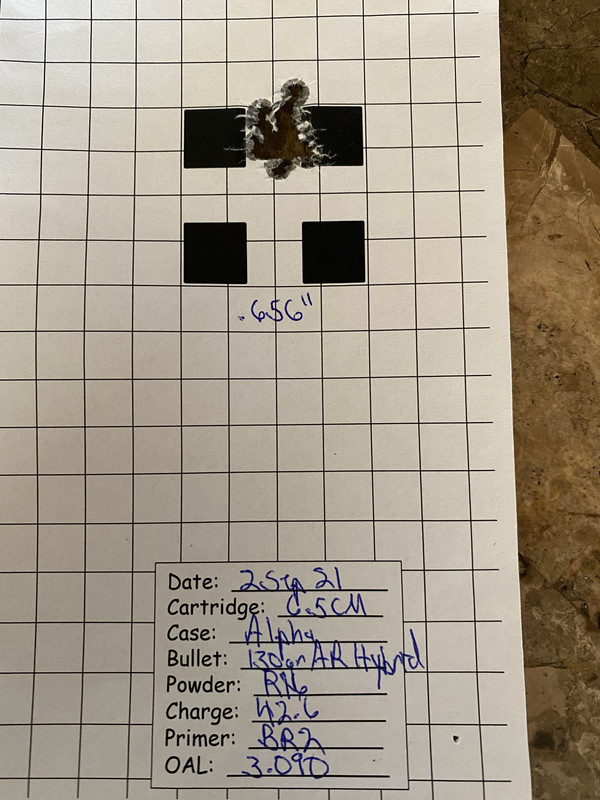Has anyone found out what barrel length gets a full burn for a max charge of whatever they are running? I was quite shocked at how much faster my 26" Proof was over the prior 22"....quite a bit more than I was expecting by the time the barrel was broken in. Just wondered as I run near a full charge with 43.8 of StaBall and hadn't thought about it since load dev until someone was asking me about my mv the other day.
Have some relevant experience with this: In a 26” barrel, powders like H4350 or IMR4350 and IMR4381SC show a small amount of muzzle flash, indicating some powder kernels are burning outside the barrel, but probably close to optimal.
When i mounted a 30” barrel, hoping to get a lot more speed, both H4350 and IMR4350 (different but very similar powders), did not gain more than about 40 or 50 fps (for a max pressure load), and slow motion video showed white smoke and no orange flame. That extra 4 inches were a waste for the traditional/popular powders. Did not achieve what i paid for.
When i tried RL-17 and Superformance, i could get closer to 80-100 fps more, which was worth the extra money i thought. [I suspect that W760 will do similar.] Btw for the heavy 6.5 mm bullets (147-156), the difference was bigger. But it became a very unwieldy rifle, and only good as a dedicated bench gun.
My conclusions at the end were as follows:
1) Don’t expect miracles from a 6.5 Creedmoor rifle by mounting say a 32 or 34” barrel. The super magnums like 338 Norma and the various 375 calibers can get good benefits from long barrels in an ELR application, but a 223 with such a long barrel will be a waste. The 6, 6.5, 7, and 7.62 mm calibers are somewhere in the middle of the weight range with a 25-28” sweet spot in terms of barrel length.
2) If you want to run a long barrel in the 29-32” range, and want to fully optimize the load, you really have to switch to different powders (with a wider pressure pulse, like the various double base powders), and try slower burning single base powders. [But do understand that double base powdwrs will wear out your barrel in about half the nr shots.]
3) Switch to heavier bullets with very high BC, in the 147 gn plus category, and pick a twist rate of 7.5 for the long heavy lead core projectiles to get the BC maximized (Stability Factor over 1.5). You will likely end up selecting different powders compared to what you use today.
4) Consider using the super long high BC mono (copper) bullets like the Seneca (124 gn with 0.294 G7 BC), and the Badlands Bulldozer-2 (135 gn with a massive G7 of 0.358) with a rather fast twist rate like 6.5 to 6.75 and freebore optimized for the bullet of choice. With the right powders from a 28 or 30” barrel, especially if you HBN coat the bullets, you will be surprised at how much speed you can get, wind drift numbers that rival the best 7 mm short action non-magnum calibers. [And no i don’t intend to publish numbers or load recipes.

] Just understand that the barrel is then dedicated to monos and will likely not probably work well with lead core bullets. Bullet disintegration and poor accuracy with lead core projectiles are likely, but try it anyway, just don’t be shocked when you see these problems. Mono projectiles are made in a lathe and are extremely concentric and symmetrical, no weird hollows or inclusions, with super sharp tips, and they are very strong, far more so than lead core bullets, so they are often accurate and do well with very fast twist rates. Of course, playing with monos and special purpose dedicated 30” custom barrels is a rather expensive hobby.
In the final analysis, BC wins out over speed. Speed drops by 30% or more by the time the bullet gets to 1000 yards. BC is mostly preserved (you only lose 5-10% in BC due to loss of speed). So a best-in-class 375 bullet going at 2800 fps will beat any 6.5 bullet going 3000 fps at distance.
Note to self: Pick caliber and barrel length based on intended use (e. g. F-class vs hunting), then optimize the load, and just accept the trade offs involved. Next time i would rather buy a new 28” barrel in 7 mm or 30 cal, rather than try to push heavy 0.264” bullets over 3100 fps. Bullet weight contributes a whole lot to BC, and BC wins out over speed.






